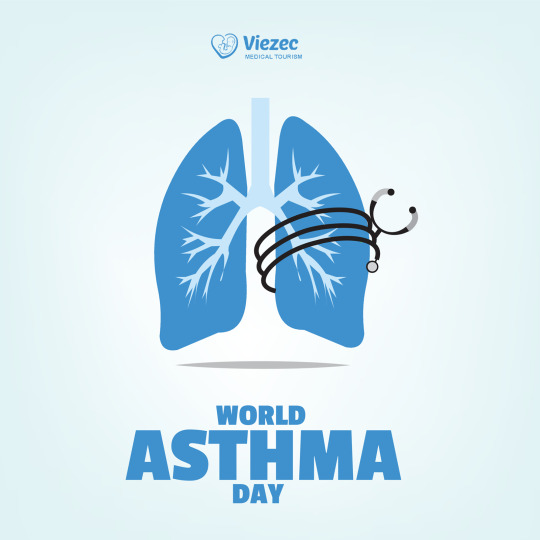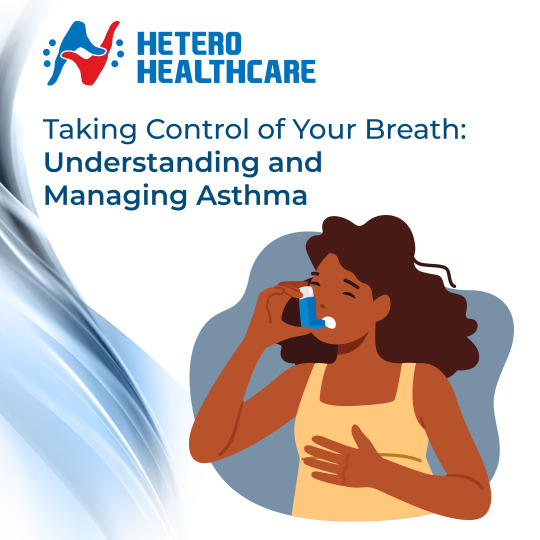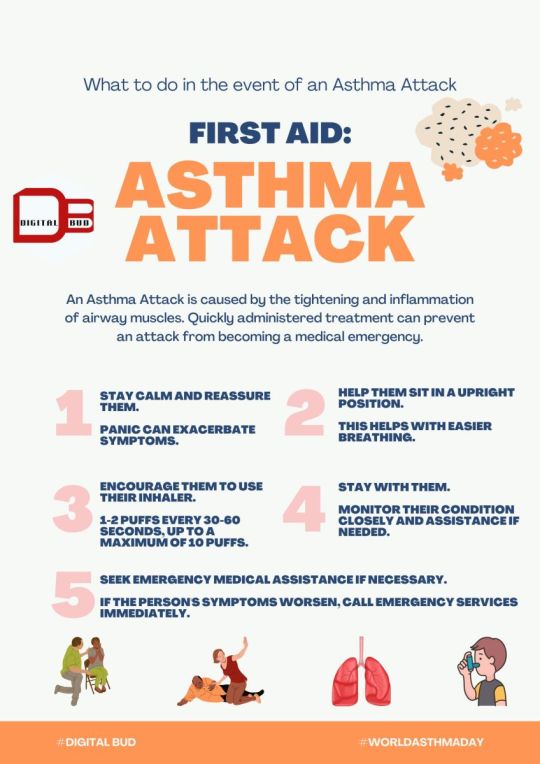#AsthmaSupport
Explore tagged Tumblr posts
Text

🫁 What Can Trigger Asthma? Know the Common Causes!
If you or a loved one lives with asthma, it's important to know what can set off symptoms. From allergens and pollution to stress and certain medications, triggers vary for everyone. Learn to identify yours and breathe easier every day. 💨💙
✅ Stay informed.
✅ Avoid your triggers.
✅ Take control of your asthma.
#AsthmaAwareness#AsthmaTriggers#BreatheEasy#AsthmaRelief#AllergySeason#LungHealth#RespiratoryHealth#AsthmaSupport#AirQualityMatters
0 notes
Text

🌍 World Asthma Day 2025 💙
Every breath matters — and everyone deserves access to better care.
At Viezec Medical Tourism, we connect patients worldwide with advanced, affordable treatment options, including promising therapies like stem cell treatment for asthma. 🫁 Asthma impacts millions, but breakthroughs in regenerative medicine are offering real hope for long-term relief and improved lung function. This World Asthma Day, we reaffirm our commitment to: ✔️ Global access to cutting-edge care ✔️ Personalized treatment journeys ✔️ Empowering patients to breathe freely again Let’s spread awareness, share hope, and move toward a healthier future — together.
#WorldAsthmaDay#ViezecMedicalTourism#BreatheWithHope#Exosomes#FutureOfMedicine#AsthmaAwareness#RegenerativeMedicine#AsthmaSupport#LungHealth#StemCellsForAsthma#BreatheEasy#InnovativeCare#HopeThroughScience#LungsDisease#Viezec
0 notes
Text

World Asthma Day 2025
Today, we stand in solidarity with the 300+ million people worldwide living with asthma. At Global Stem Cell Care, we believe in a future where cutting-edge science and compassionate care come together to bring real relief. 🧬 Our focus on advanced stem cell therapy offers promising potential to reduce inflammation, regenerate lung tissue, and address the root causes of chronic respiratory issues, including asthma. Let’s raise awareness, encourage early intervention, and explore innovative treatments that give patients more than just short-term relief — they deserve lasting change. 💙
#WorldAsthmaDay#GlobalStemCellCare#BreatheWithHope#Exosomes#FutureOfMedicine#AsthmaAwareness#RegenerativeMedicine#AsthmaSupport#LungHealth#StemCellsForAsthma#BreatheEasy#InnovativeCare#HopeThroughScience#LungsDisease#GSCC
0 notes
Text
youtube
World Asthma Day: Can Stem Cells Revolutionize Asthma Treatment? |
🫁 Asthma may restrict airways, but it can’t restrict hope. This World Asthma Day, we spotlight the potential of stem cell therapy in redefining asthma care.
🌱 Stem cells have shown encouraging results in repairing lung tissues, modulating immune responses, and reducing chronic inflammation, key factors in managing asthma beyond symptom control.
At Stem Cell Care India, we’re pioneering paths toward a future where breathing isn’t a struggle — it’s natural.
#WorldAsthmaDay#StemCellCareIndia#BreatheWithHope#Exosomes#FutureOfMedicine#AsthmaAwareness#RegenerativeMedicine#AsthmaSupport#LungHealth#StemCellsForAsthma#BreatheEasy#InnovativeCare#HopeThroughScience#LungsDisease#Youtube
0 notes
Text
World Asthma Day
🌬️ Take a deep breath – and take control. This World Asthma Day, let’s spread awareness and support those living with asthma.

#WorldAsthmaDay#AsthmaAwareness#BreatheEasy#FightAsthma#AsthmaSupport#AsthmaCare#HealthyLungs#StopForAsthma#BreathOfLife#AsthmaEducation
0 notes
Text

🚭 Today’s Cigarette Could Be Tomorrow’s Inhaler!
Smoking today might cost you your breath tomorrow. This World Asthma Day, let's choose lungs over lifestyle. 💨 Quit smoking. 💙 Breathe better. 🏥 Visit CRonus Multi Speciality Hospital for asthma care & respiratory health.
📞 Book Now: +91-982-186-6447 🌐 www.cronushospitals.com
#WorldAsthmaDay#StopSmokingStartLiving#BreatheEasy#AsthmaAwareness#LungHealth#CronusHospital#RespiratoryCare#SayNoToSmoking#HealthyLungs#AsthmaSupport#PulmonologyCare#QuitSmokingNow#NoTobacco#BreatheFree#HealthcareAwareness
0 notes
Text

Asthma and Diabetes: Expert Advice and Practical Tips
Explore essential tips and expert advice for managing asthma and diabetes. Equip yourself with knowledge for a healthier, more fulfilling life.
#AsthmaAndDiabetes#ChronicConditions#DiabetesManagement#AsthmaCare#HealthyLivingTips#BreatheBetterLiveBetter#ManagingChronicIllness#DiabetesAwareness#AsthmaSupport#WellnessJourney
0 notes
Text

Interior design with bricks made of Himalayan pink salt
The use of pink salt in the interior design is a new method to allure the guests visually. With Himalayan salt bricks, you can create wall art in your home, and it is suitable for your bedrooms, sitting areas, and hallways. It can make your interior fascinating and mesmerizing. Wall panels or salt lamps placed in your room or sitting area will make your house look more beautiful. The health benefits of Himalayan salt will make your home a wellness retreat.
#saltproducts#HimalayanSaltTherapy#RespiratoryRelief#AsthmaSupport#SaltTileHealing#NaturalSkinCare#StressManagement#MoodEnhancement#WellnessWithSalt#HolisticHealing#SaltForHealth#USAWellness#BoostYourHealth
0 notes
Text
Taking Control of Your Breath: Understanding and Managing Asthma

Asthma is a chronic respiratory condition that affects the airways in the lungs, making it difficult for people to breathe. For those living with asthma, managing this condition is essential to living a full, healthy life. Understanding what triggers asthma, how to recognize symptoms, and the treatments available are all critical to managing it effectively. This post will explore what asthma is, its symptoms, triggers, treatment options, and lifestyle tips to help you take control of your breathing.
What is Asthma?
Asthma is a condition where the airways become inflamed and narrow, which can lead to difficulty breathing. This happens because of inflammation in the bronchial tubes (the airways) that carry air in and out of the lungs. During an asthma attack, these airways swell even more, the muscles around them tighten, and the body produces excess mucus, making it even harder to breathe.
Asthma affects people of all ages and often starts during childhood, although it can develop later in life as well. According to the Centers for Disease Control and Prevention (CDC), more than 25 million people in the United States have asthma, which equates to about 1 in 13 people.
Types of Asthma
Asthma can be categorized into different types, depending on the triggers and how it presents itself:
Allergic Asthma: Triggered by allergens like pollen, dust mites, pet dander, and mold.
Non-Allergic Asthma: Caused by irritants in the air such as smoke, chemicals, strong odors, or weather changes.
Exercise-Induced Asthma (EIA): Triggered by physical exertion, particularly during exercise.
Occupational Asthma: Caused by irritants in the workplace, such as chemicals, dust, or fumes.
Nocturnal Asthma: Asthma symptoms that worsen at night, potentially disrupting sleep.
Cough-Variant Asthma: Characterized by a persistent, dry cough and no other classic asthma symptoms.
Symptoms of Asthma
Asthma symptoms vary from mild to severe and can differ from one person to another. Some individuals may experience symptoms only occasionally, while others have daily symptoms. Recognizing these symptoms early can help you manage your asthma more effectively and avoid serious complications.
Common symptoms include:
Shortness of breath: You may feel breathless and unable to take deep breaths, especially during physical activity or after exposure to a trigger.
Chest tightness: A sensation of tightness or pressure in the chest, which can make breathing uncomfortable.
Wheezing: A whistling or squeaky sound when you breathe, often heard when exhaling.
Coughing: A persistent cough, especially at night or early in the morning. In some cases, this can be the only symptom.
Fatigue: During an asthma flare-up, the effort required to breathe can leave you feeling exhausted.
Difficulty sleeping: Symptoms like coughing, wheezing, or shortness of breath can interfere with restful sleep.
Common Triggers of Asthma
Asthma triggers are things that irritate your airways and make asthma symptoms worse. Identifying and avoiding your asthma triggers is a key part of managing the condition. Some common asthma triggers include:
Allergens: Pollen, dust mites, mold, and pet dander can all trigger asthma symptoms in individuals with allergic asthma.
Air pollutants: Smoke from cigarettes, wood-burning stoves, and vehicle exhaust can irritate the airways.
Cold or dry air: Breathing in cold, dry air can cause asthma symptoms to flare, especially in people with exercise-induced asthma.
Respiratory infections: Colds, flu, and other respiratory infections can trigger asthma attacks or worsen symptoms.
Physical activity: For some people, exercise—especially in cold air—can trigger asthma symptoms.
Strong emotions: Stress, anxiety, or intense laughter can sometimes trigger asthma symptoms.
Certain medications: Medications such as beta-blockers or aspirin can sometimes trigger asthma in sensitive individuals.
Managing and Treating Asthma
While there is no cure for asthma, it can be managed effectively with the right combination of medication and lifestyle adjustments. Your asthma action plan should be developed with the help of your healthcare provider, and it may include several approaches:
1. Medications
Asthma medications generally fall into two categories: long-term control medications and quick-relief (rescue) medications.
Long-term control medications: These are taken daily to keep asthma under control and reduce inflammation in the airways. Inhaled corticosteroids, leukotriene modifiers, and long-acting beta-agonists are commonly prescribed for this purpose.
Quick-relief (rescue) medications: These medications are used to quickly relieve asthma symptoms during an attack. Short-acting beta-agonists, such as albuterol, are often used in a rescue inhaler to open up the airways during a flare-up.
Biologics: For individuals with severe asthma that is not well-controlled with standard medications, biologic therapies may be used. These target specific pathways in the immune system that contribute to asthma inflammation.
2. Inhalers and Nebulizers
Many asthma medications are delivered through inhalers or nebulizers. Inhalers are portable devices that deliver medication directly into your lungs. A nebulizer is a machine that turns liquid medication into a fine mist, which is then inhaled through a mask or mouthpiece. These devices are important tools for both preventing asthma symptoms and managing flare-ups.
3. Lifestyle Changes
Making lifestyle changes can also help you manage your asthma symptoms and reduce the frequency of attacks:
Avoid triggers: Identify and avoid known triggers such as allergens, pollution, or extreme weather conditions.
Monitor your breathing: Use a peak flow meter to measure how well your lungs are working. This can help you identify changes in your breathing that may indicate an impending asthma attack.
Exercise regularly: Physical activity is important for overall health, but it’s important to work with your healthcare provider to find safe ways to exercise with asthma. Activities like swimming, walking, or biking are generally recommended.
Stay on top of colds and flu: Asthma symptoms often worsen with respiratory infections. Get a flu shot every year, and wash your hands regularly to avoid infections.
Maintain a healthy diet: Eating a diet rich in fruits, vegetables, and omega-3 fatty acids can help reduce inflammation and boost overall health.
Manage stress: Emotional stress can worsen asthma symptoms. Practice stress-reducing techniques such as deep breathing, yoga, or meditation.
4. Asthma Action Plan
Work with your doctor to create an asthma action plan. This written plan should outline the steps to take when you are feeling well, when you begin to have symptoms, and when your symptoms become severe. It will also include information about your medications, triggers, and when to seek emergency medical care.
Asthma in Children
Asthma is one of the most common chronic conditions in children. Managing asthma in children requires special care because young children may not be able to articulate their symptoms. Parents and caregivers should work closely with healthcare providers to develop a plan for managing asthma and monitoring symptoms.
Tips for Managing Asthma in Children:
Ensure your child takes long-term medications as prescribed, even if they feel fine.
Keep their quick-relief inhaler accessible at all times, especially during sports or outdoor activities.
Encourage your child to tell you if they feel any asthma symptoms, even if they’re mild.
Educate your child’s school or caregivers about their asthma action plan, including what to do during an asthma attack.
When to Seek Emergency Help
Asthma can be life-threatening if not managed properly. Knowing when to seek emergency medical help is crucial. Call for immediate medical attention if:
You have severe difficulty breathing and cannot catch your breath.
Your rescue inhaler is not providing relief.
You experience extreme chest tightness or pain.
You have difficulty speaking or walking due to shortness of breath.
Your lips or face turn blue.
Final Thoughts
Asthma can be challenging, but with proper management, most people with asthma can live full, active lives. By understanding your triggers, using the right medications, and working with your healthcare provider to develop an asthma action plan, you can take control of your breathing and manage your asthma effectively.
If you or someone you love has asthma, don’t hesitate to seek help from a healthcare provider. With the right tools and knowledge, asthma doesn’t have to control your life—you can control your asthma.
#AsthmaAwareness#BreatheEasy#AsthmaManagement#AsthmaSupport#LivingWithAsthma#RespiratoryHealth#AsthmaRelief#ManageYourAsthma#AsthmaLife
0 notes
Text

Struggling with your child’s mood swings or focus issues? Asthma might be playing a bigger role than you think. Poor sleep, medication side effects, and stress from asthma can lead to behavior problems in kids. Learn how to spot the signs and support your child’s emotional well-being. 💙
#AsthmaAwareness#ChildBehavior#PediatricAsthma#AsthmaAndMentalHealth#ParentingTips#AsthmaInChildren#AsthmaSupport#ChildHealth#BehaviorProblems
0 notes
Text

Understand asthma, common triggers, and effective management strategies. Learn about the unique challenges of managing asthma in India and discover ways to overcome them.
https://www.heterohealthcare.com/blog/taking-control-of-your-breath-understanding-and-managing-asthma
0 notes
Text

🌍✨ Today, we recognize #WorldAsthmaDay, a global initiative to raise awareness about asthma, its challenges, and ways to manage it. Let's come together to support those affected by asthma, spread knowledge about triggers, and advocate for better access to treatment and care. Together, we can breathe easier and create a world where asthma no longer holds anyone back.
#WorldAsthmaDay#AsthmaAwareness#BreatheEasy#AsthmaManagement#HealthyLungs#InhalerHero#AsthmaWarrior#AsthmaSupport#OpenAirways#LungHealth#NoMoreWheezing#TakeControl#BreathingEasy#AsthmaEducation
0 notes
Text
07th May, 24 | World Asthma Day
World Asthma Day is a globally recognized event dedicated to raising awareness about asthma, a chronic respiratory condition affecting millions worldwide. 🌍 Why World Asthma Day is IMPORTANT: Awareness: It serves as a platform to educate individuals, families, and communities about asthma, its causes, symptoms, and management. Advocacy: World Asthma Day advocates for improved asthma care and…

View On WordPress
#AsthmaAwareness#AsthmaSupport#BreatheEasy#FightAsthma#HealthyLungs#RespiratoryHealth#WorldAsthmaDay
0 notes
Text
Understanding Asthma: Causes, Symptoms and Treatment
youtube
Embark on a journey to comprehend asthma, a respiratory condition affecting millions worldwide. This comprehensive guide explores the causes, symptoms, and various treatment options for effective asthma management. Enhance your awareness and empower yourself or others with valuable insights.
#AsthmaAwareness#RespiratoryHealth#AsthmaEducation#SymptomsOfAsthma#BreatheEasy#AsthmaManagement#LungHealth#InhalerTherapy#AsthmaSupport#EmpowerWithKnowledge#Youtube
0 notes
Text
𝐒𝐡𝐨𝐫𝐭𝐧𝐞𝐬𝐬 𝐨𝐟 𝐁𝐫𝐞𝐚𝐭𝐡 𝐦𝐢𝐠𝐡𝐭 𝐛𝐞 𝐚 𝐬𝐲𝐦𝐩𝐭𝐨𝐦 𝐨𝐟 𝐀𝐬𝐭𝐡𝐦𝐚!
Don't take a chance on your child's health! 𝐃𝐨 𝐂𝐨𝐧𝐬𝐮𝐥𝐭 𝐎𝐮𝐫 𝐏𝐚𝐞𝐝𝐢𝐚𝐭𝐫𝐢𝐜 𝐒𝐩𝐞𝐜𝐢𝐚𝐥𝐢𝐬𝐭𝐬!
For Any Appointment Booking: 📅:: https://prathimahospitals.com/book-appointment/ 📞:: 733 733 6600 | 040 4345 4345

#asthma#childhealth#shortnessofbreath#paediatric#AsthmaAwareness#AsthmaSymptoms#BreatheEasy#AsthmaSupport#AsthmaEducation#AsthmaPrevention#paediatrician#childrendoctor#prathimahospitals#ph
0 notes
Text
🫁 Breathe Better Every Day with LungExpand Pro: The Natural Way to Strengthen Your Lungs
🌬️ What is LungExpand Pro?
LungExpand Pro is a natural respiratory trainer that works by creating resistance as you inhale. This trains your lungs, much like lifting weights trains your muscles. Whether you’re an athlete, a singer, or someone looking to improve breathing due to asthma, COPD, or simply aging, LungExpand Pro gives you the support you need.
🔬 How Does It Work?
LungExpand Pro uses adjustable resistance levels to help strengthen the respiratory muscles, improve oxygen intake, and boost overall lung function. It’s backed by research that shows regular use of a breathing trainer can:
✅ Improve lung capacity ✅ Reduce breathlessness ✅ Increase oxygen delivery to your muscles ✅ Support cardiovascular health ✅ Enhance physical performance
The best part? You only need to use it for a few minutes a day.
🧘♂️ Who Should Use LungExpand Pro?
LungExpand Pro is perfect for:
People with asthma or other breathing difficulties
Seniors who want to maintain lung function
Athletes and singers who depend on powerful lungs
Anyone recovering from respiratory illness or fatigue
Everyday folks looking to improve stamina and energy naturally
This compact device is travel-friendly, easy to use, and requires no batteries or chemicals — just natural breathing power.
💡 Real Results, Real People
Here’s what users are saying about LungExpand Pro:
📈 Why LungExpand Pro Is a Smart Long-Term Investment
Unlike medications or inhalers that provide short-term relief, LungExpand Pro trains your body to become stronger and more efficient on its own. It’s a safe, natural, and non-invasive solution to better breathing and overall wellness.
✅ No side effects ✅ Compact and easy to use ✅ Backed by science and user reviews ✅ Boosts immunity through better oxygen intake
🔗 Internal Link Suggestions:
Want to learn how to use LungExpand Pro effectively? Check our step-by-step guide here.
Looking for answers? See our LungExpand Pro FAQ.
🚀 Ready to Breathe Like Never Before?
If you're ready to take control of your breathing and feel better in your body, it’s time to try LungExpand Pro. Join thousands who are experiencing deeper breaths and healthier lives every day.
👉 Visit lungexpandpro-shop.com and get started today.
📣 Share Your Journey
Have you tried LungExpand Pro yet? Let us know how it’s working for you in the comments, or share this post with someone who could use a breath of fresh air! 💬💨
#LungExpandPro #BetterBreathing #LungHealth #RespiratoryTrainer #NaturalHealth #WellnessTools #COPDRelief #AsthmaSupport #HealthyLungs #Breathwork #TumblrHealth #TumblrFitness #BingSEO #FitnessTips #BreatheBetter
Breathe Deeper, Live Better with LungExpand Pro
Why LungExpand Pro Is the Game-Changer Your Lungs Have Been Waiting For
"Has anyone used LungExpand Pro to improve lung capacity or recover from shortness of breath? How effective was it for boosting respiratory health
naturally?"
Unlock the Power of Every Breath with LungExpand Pro
Breathe Smarter, Live Stronger: Why LungExpand Pro Is the Natural Upgrade Your Lungs Deserve
"Can using a device like LungExpand Pro really improve lung capacity and boost energy naturally without medication?"
2 notes
·
View notes